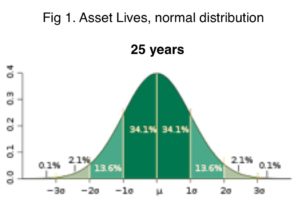 In our current data driven environment, there is still a role for common sense
In our current data driven environment, there is still a role for common sense
A few years ago, using its renewal model, a council was advised that its buildings were 60% overdue for replacement. This came as a great surprise to the Council – but should it have? If true, one would have imagined that there would be many visible signs of major deterioration – non-habitable buildings boarded up for safety, signs of breakdown in buildings still in use (e.g. lifts, plumbing or HVAC not working), union demonstrations, protest movements, etc. If true, this should not have been any surprise to council, their own user experience would have told them that it was true. So what is happening here?
“All models are wrong, but some are useful.” Statistician George Box.
Jeff Roorda, in his post asked ‘why focus on the measurement of physical life using condition instead of looking at function and capacity?’ A very sound question. Function and capacity determine economic life, or useful life (how long we can expect the asset to be of use to us) rather than how long it will physically last. His question is part of a wider range of questions about how we use models.
The first thing to note is that renewal models are financial models. They are based on averages of a group and say nothing about the time to intervene (i.e. replace) for any individual asset. When we say that an asset, or an asset component, has a useful life of 25 years, what is really to be understood is that assets of this type may fail at 15 years or even earlier and perhaps as late as 40 years or more but that when we take them as a whole, their useful lives will average out to about 25 years. This is a guide to financial planning.

Because 25 is an average (and assuming we have a normal distribution and not one that is severely skewed) then we can expect that half of these assets will fail before the age of 25 and half will fail after the age of 25, as shown here in figure 1. Thus we cannot assume that just because an asset is greater than 25 years that it is ‘due for replacement’
This is the mistake made by the council, and why it came as such a surprise to the Councillors.
Our instincts may not be infallible but when intuition clashes with the results of a model, it pays to check both our understanding – and our interpretation of the model.

I could not agree more. As I use “Availability Workbench” to model reliability of components and their effects on system functions, I always start presentation of results (for our board of directors) by stating: 1) each model is a simplification of the real world; 2) each model, although validated, holds errors; 3) each result is generated by statistical simulation with a statistical distribution as base (failure can occur much earlier or long after predicted outcome) 4) each result needs interpretation. Or, common sense.
Besides this example, I see the tendency of considering “Condition Based Maintenance” (CBM) being translated as “we put sensors in every component” and seeing this as the future of Asset Maintenance. ‘Cause “When we measure, we’ll always find something”. Common sense? No. Common sense and engineering is needed here, by knowing the relevant failure modes and their characteristics (failure distribution). And then decide whether CBM is applicable.
Knowing the basis of the models and methods used is the key to interpretation.
In my “humble” opinion, this post is ground zero for the future of all infrastructure asset management. I would classify the use of “life” in financial planning (as per the post) and “failure” in Mr. Nagelhout’s comment, as the modern asset management approach. While in some cases there may be correlation between the asset’s age and time to failure, causation is difficult to establish. Conditional and functional performance measures, as observed by organizations with limited funding, are the causation factors. In terms of terminology, we do not manage assets to failure, but rather to treatment.
If I may proclaim a post-modern approach, at a strategic level, it would be composed of applying reliability theory to (all) organizational information. It’s post-modernism would come from taking a different path to modelling infrastructure behavior, one that is not constrained only to engineering probability modeling of instrumented assets. Although all the performance measures (or decision measures / factors) upon which professionals have been making decisions for decades, may have not been explicitly recorded, their output has. These are financial, engineering, and administrative records of information. With unconstrained access to these, one is able to develop an explicit quantitative model with one unified performance measure of previously defined and undefined, explicit and implicit decision factors. This can be done within one year for any size of organization / asset network. Accuracy of the model is proportional to the quantity of information analyzed, hence, it is important to review all information. Once complete, the model is not the predictor of future reality, but a JIT factory for future scenarios from the most granular asset information to the overall network. A factory, which as any manufacturing facility, needs to be continuously improved to stay current.